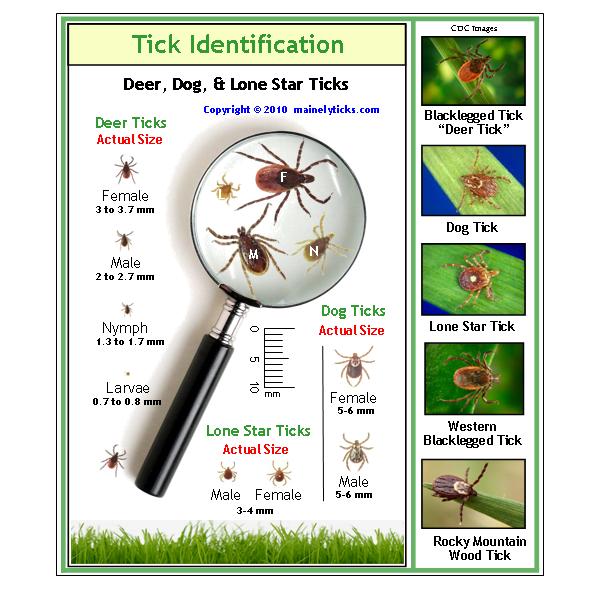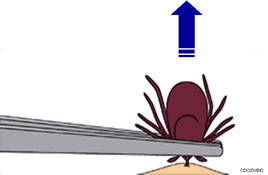
 Please note that the chart above is not to scale since you are viewing it a computer screen. It is meant to provide general information and a visual indicator of what ticks look like at various stages of their lifecycle.
Please note that the chart above is not to scale since you are viewing it a computer screen. It is meant to provide general information and a visual indicator of what ticks look like at various stages of their lifecycle. Download a PDF here to Identify Ticks.
Chart shown above courtesy of Mainely Ticks.
Identifying ticks
Use the chart to the right to help you identify ticks and to recognize them in their various stages of development. Remove any ticks you find crawling on you or your clothing, and remove with care any ticks that you find that are already embedded to you or a family member's body. You can download a a full color PDF which includes this tick identification chart, removal information and submission information by selecting here.
Remove ticks carefully

Using a pair of fine pointed tweezers, grasp the tick as close as possible to the skin. Pull straight out with a steady motion. A tick’s mouthpart is barbed like a fish-hook. It may take several minutes of applying steady pressure for the tick to let go. Avoid squishing the tick or pulling side-to side. Do not use vasoline or a lit match, and avoid twisting or squeezing the tick with your fingers as this may inject the content of the tick's gut into your bloodstream.
• Wash the site thoroughly with soap and water, disinfect with antiseptic.
• If black-legged tick was engorged, contact your physician for treatment.
• Early signs and symptoms of Lyme disease may include an expanding red rash,
flu-like symptoms, and/or joint pain and swelling. Only 40% to 70% of Lyme disease victims may develop a rash within two days to four weeks. If left untreated, more severe symptoms may develop, sometimes months to years later.
Always watch the site of any tick bite very carefully and contact your doctor if you develop any signs or symptoms of Lyme disease.
The most important step in avoiding Lyme disease is a daily tick check.
Ticks are opportunistic and can "hitch a ride" whenever you are outdoors so it is a good idea to wear light colored clothing. Any tick that gets on your clothing will be more easily seen, discovered and disposed of quickly before they can embed themselves. Ticks can survive water so do not flush them. The best way to get rid of them is to put them in a container with alcohol to kill them. Also during a daily shower examine yourself closely for any that you may have missed when checking your clothing.